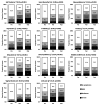The Prevalence and Patterns of Menopausal Symptoms in Women Living with HIV
- PMID: 35604509
- PMCID: PMC9550775
- DOI: 10.1007/s10461-022-03696-4
The Prevalence and Patterns of Menopausal Symptoms in Women Living with HIV
Abstract
Increasing numbers of women with HIV are experiencing menopause. We use data from a large, representative sample of women with HIV to describe the prevalence and clustering of menopausal symptoms amongst pre-, peri- and post-menopausal women using hierarchical agglomerative cluster analysis. Of the 709 women included, 21.6%, 44.9% and 33.6% were pre-, peri- and post-menopausal, respectively. Joint pain (66.4%) was the most commonly reported symptom, followed by hot flashes (63.0%), exhaustion (61.6%) and sleep problems (61.4%). All symptoms were reported more commonly by peri- and post-menopausal women compared to pre-menopausal women. Psychological symptoms and sleep problems clustered together at all menopausal stages. Somatic and urogenital symptom clusters emerged more distinctly at peri- and post-menopause. We recommend regular and proactive assessment of menopausal symptoms in midlife women with HIV, with an awareness of how particular patterns of symptoms may evolve over the menopausal transition.
Keywords: Ageing; HIV; Menopause; Symptoms.
© 2022. The Author(s).
Conflict of interest statement
The authors have no relevant financial or non-financial interests to disclose.
Figures


Similar articles
-
How do women living with HIV experience menopause? Menopausal symptoms, anxiety and depression according to reproductive age in a multicenter cohort.BMC Womens Health. 2021 May 28;21(1):223. doi: 10.1186/s12905-021-01370-w. BMC Womens Health. 2021. PMID: 34049547 Free PMC article.
-
Comparison of various menopausal symptoms and risk factor analysis in Korean women according to stage of menopause.Maturitas. 2020 Oct;140:41-48. doi: 10.1016/j.maturitas.2020.05.023. Epub 2020 Jun 13. Maturitas. 2020. PMID: 32972634
-
Frequency of symptoms, determinants of severe symptoms, validity of and cut-off score for Menopause Rating Scale (MRS) as a screening tool: a cross-sectional survey among midlife Nepalese women.BMC Womens Health. 2011 Jun 14;11:30. doi: 10.1186/1472-6874-11-30. BMC Womens Health. 2011. PMID: 21672198 Free PMC article.
-
Symptoms of menopause - global prevalence, physiology and implications.Nat Rev Endocrinol. 2018 Apr;14(4):199-215. doi: 10.1038/nrendo.2017.180. Epub 2018 Feb 2. Nat Rev Endocrinol. 2018. PMID: 29393299 Review.
-
Sleep disturbance and menopause.Curr Opin Obstet Gynecol. 2025 Apr 1;37(2):75-82. doi: 10.1097/GCO.0000000000001012. Epub 2025 Jan 17. Curr Opin Obstet Gynecol. 2025. PMID: 39820156 Review.
Cited by
-
Menopause: an opportunity to optimize health and well being for people with HIV.Curr Opin HIV AIDS. 2025 Jul 1;20(4):388-395. doi: 10.1097/COH.0000000000000944. Epub 2025 Apr 21. Curr Opin HIV AIDS. 2025. PMID: 40232823 Free PMC article. Review.
-
Menopausal symptoms by HIV status and association with health-related quality of life among women in Zimbabwe: a cross-sectional study.BMC Womens Health. 2023 Jun 29;23(1):343. doi: 10.1186/s12905-023-02466-1. BMC Womens Health. 2023. PMID: 37386415 Free PMC article.
-
Substance use and menopausal symptoms among people with and without HIV in the US, 2008-2020.Menopause. 2024 Oct 1;31(10):911-920. doi: 10.1097/GME.0000000000002405. Menopause. 2024. PMID: 39319622
-
HIV Infections and Prevention in Women.Clin Obstet Gynecol. 2025 Jun 1;68(2):159-163. doi: 10.1097/GRF.0000000000000939. Epub 2025 Mar 25. Clin Obstet Gynecol. 2025. PMID: 40128637 Free PMC article. Review.
-
The association between HIV infection and perimenopausal syndrome: A matched cross-sectional study of women living with HIV/ AIDS and their uninfected counterparts in rural areas of Anhui, China.Glob Health Med. 2024 Oct 31;6(5):339-344. doi: 10.35772/ghm.2024.01050. Glob Health Med. 2024. PMID: 39483450 Free PMC article.
References
-
- Brown A, Rawson S, Kelly C, et al. Women and HIV in the UK. 2019.
MeSH terms
Grants and funding
LinkOut - more resources
Full Text Sources
Medical

